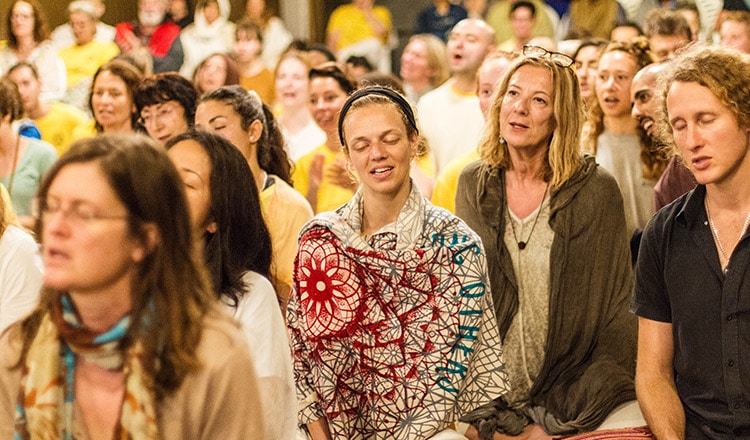Sivananda Bahamas Blog
Expand Your Horizons …
Our Blog
The Meaning of Satsang
“...the beginner will do well to take the opportunity that comes in his way to strengthen his own aspirations by communion with others who share them.”
— Swami Sivananda, Bliss Divine
Everyone is encouraged to attend both satsangs every day in the ashram. Swami Brahmananda describes satsang as being in the company of truth. “Swami Sivananda explains that when people practice together, there is collective force and everyone receives benefit,” he says.
He also explains that when we are in the company of fellow aspirants, inspirational teachers, and positive examples, we receive knowledge directly. “The spiritual energy of satsang — the meditation, chanting, and teachings that take place at every gathering — purifies all impure perceptions, he says. “This is why the group is much more powerful. All aspects of satsang remould who we are energetically, mentally, and spiritually.”
The individual elements of satsang each have benefits that are magnified by the group energy. Meditation becomes more powerful when practiced together. Chanting connects us and opens the heart. The teachings purify the way we perceive our own realities. The satsangs take place twice daily: In the morning, the satsang plants the seeds to elevate the day, and in the evening it closes the day, elevating the night’s sleep.
Unity in Diversity, the ashram’s belief and practice, describes a world where people from all walks of life can come together and let all prejudices fall away. These prejudices are barriers for spiritual evolution, so Unity in Diversity is an essential goal of yogic life and all invited to come together for satsang.
Three ashram-goers share their own satsang experiences:
Sandrine Remy (Sanatani)
Sanatani’s earliest struggle was with the discipline of attending all satsangs. “I resisted being there sometimes, especially if I had heard the presenter before.”
She has now been visiting the ashram as a karma yogi for the past eight years, usually for six months a year. She’s found herself embracing different parts of the satsang over time. “I really started to enjoy the chanting this season,” she said. “I put all my heart into it. I I also like the diversity of what is offered here.”
A beginner struggles, Sanatani acknowledged. “But over the years we understand more,” she says. “It took time and now I enjoy the gathering. It’s important, the synergy of coming together.”
Marlene Vezzaro (Sita)
The first time Sita visited the ashram for one day was when she took a break from her resort holiday. “I didn’t like it at that time. I was into the more physical yoga,” she says. “I had no idea what spirituality was.”
“The first days of satsang were difficult,” Sita admits. “I wasn’t familiar and it was challenging. I was sitting in the back, so intimidated by the people.”
She joined Swami Shambudevanada’s Essentials of Meditation Course to deepen her understanding. Gradually, her shyness began to dissipate, especially during kirtan. “The more you do, the less you’re shy,” she says. “I even chanted for the group at the end of our silent walk on the beach.”
Sita also began to open up to the different presenters in the satsangs, who give presentations on topics including healing, yoga philosophy, spirituality, kirtan, neuroscience, and health. “The teachings are amazing,” she says. “It’s like an open window, encouraging you to go deeper. The speakers show what can be done and give ideas. They motivate you to serve humanity.”
But the spiritual path isn’t always linear. After engaging in the community even more by taking her Yoga Teacher Training (TTC) and Advanced Yoga Teacher Training (ATTC), Sita felt a void come into her practice. “After ATTC I was feeling disconnected, even at satsang,” she said. “Swami Bramananda came to me and said, ‘Sit in the front and don’t leave.’ I felt like I was part of the family.”
Claire Matlak (Bhargavi)
Bhargavi had never been to a satsang before she arrived at the ashram in March 2017, but she had grown up in going to church, participating in drum circles and other gatherings, so she felt comfortable in a group setting.
A musician herself, she immediately loved the singing and the instruments, but it took time to figure out some of the rituals. “I remember being confused by some of the gestures in the closing prayer, the Arati,” she said. “And when we bowed, I didn’t know why.”
After nearly a year as a karma yogi at the ashram, she is fully connected with the satsang — the stillness of meditation, the music, and most of all the community, she says. “Sitting together each time makes a difference.”









One thought on “The Meaning of Satsang”
Jonathan Caldwell
Iys truly a blessing and pleasure to attend satsang virtually with you all and look forward to visiting the ashram one day